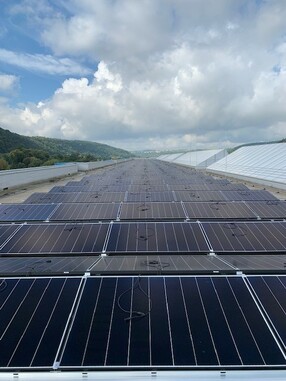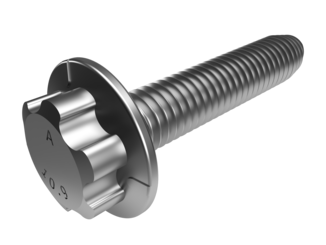
Arnold Umformtechnik also regularly prepares greenhouse gas balances in order to continuously explore the potential for climate protection measures throughout the company. Data collection for a meaningful carbon footprint is costly and complex, but worthwhile: Since 2021, production at the manufacturer of high-quality fastening systems and precision parts has been considered climate-neutral.
Against the backdrop of buzzwords such as climate change, the Kyoto Protocol and greenhouse gas emissions, managers of industrial companies are also aware of their responsibility for future generations and our planet Earth.

© Arnold Forming Technology
Arnold Umformtechnik, an international market leader for high-performance fastening systems and precision parts, wants to set a good example and join forces: energy consumption and thus greenhouse gas emissions at the production sites are to be further reduced.
Climate-neutral production is an important component of the ambitious plans, as Frank Agner, Managing Director at Arnold, emphasizes: “Arnold follows the triple principle of avoidance, reduction and compensation. Offsetting is the last step to compensate for currently unavoidable emissions already today.”
The extent of the emissions is recorded in a carbon footprint at Arnold: In 2018, a carbon footprint (also known as CO2e or greenhouse gas footprint) was prepared for the first time for the sites in Dörzbach, Ernsbach and Neu-Kupfer. The necessary data for the preparation of the 2021 carbon footprint is currently being collected.
With the help of KlimAktiv Consulting GmbH, a consulting company for individual climate protection strategies and climate neutrality based in Tübingen, the meaningful “data treasure” is collected and published: Greenhouse Gas Protocol (GHG) is the name of the greenhouse gas protocol which, along with the ISO standard with the number 14064, marks the standard for the preparation of climate accounting.
The GHG Protocol is the most widely used climate accounting standard in the world. In the GHG Protocol, CO2 emissions are determined in so-called scopes: Scope 1 (direct emissions), Scope 2 (indirect emissions from energy purchases) and Scope 3 (upstream and downstream indirect emissions). The focus of climate neutrality is currently on Scope 1 & 2, as the data basis and the ability to influence Scope 3 are not yet sufficiently available. All three scopes are recorded and analyzed in detail in the balance sheet.
For Frank Agner, the balance sheet figures are very revealing. “Relevant emission sources in the company are identified and, as a result, meaningful reduction measures can be derived to further reduce greenhouse gas emissions in the future. Against the backdrop of climate change, not only our customers but also the people from the region expect more transparency about how we are making the business model even more sustainable,” the CEO emphasizes.

© Arnold Forming Technology
Arnold will invest around four million euros in energy management between 2018 and 2023. Arnold’s energy management team pursues both operational and strategic goals in optimizing its own emissions. From a strategic point of view, the transparency of energy flows should be increased and energy use further reduced. The procurement level of thermal and electrical energy is also to be reduced further in order to cut CO2 emissions even further.
Arnold is pursuing operational goals in energy management with, among other things, an optimization of the lighting concept and a reduction in the consumption of compressed air, heating oil and electricity. The industrial company also has high hopes for heat recovery from the exhaust air in the hardening shop. To further reduce CO2 emissions and ensure climate-neutral production, Arnold will increasingly rely on the purchase of green electricity. The indirectly sourced energy (Scope 2) that Arnold requires for its business operations is already designated as energy from renewable sources through Guarantees of Origin.
Since 2021, Arnold has been offsetting unavoidable emissions in Scope 1 with so-called Gold Standard certificates. The Gold Standard was developed in 2003 by the World Wildlife Fund (WWF) and other non-governmental organizations (NGOs) to emphasize not only environmental sustainability in projects that reduce CO2 emissions, but also to stimulate sustainable development from a social perspective. The Gold Standard is considered one of the highest standards currently available in the field of climate protection projects.
On the recommendation of the cooperation partner KlimAktiv Consulting GmbH, Arnold has been supporting a carefully selected climate protection project since January 2021. In selecting the project, it was important to Arnold to support a technology-based project. Technology-based projects, for example, compared to reforestation projects, ensure that they actually deliver the desired CO2 reductions.
Energy management measures
The Arnold management is in constant exchange with the energy management team. More and more projects are being implemented at Arnold where energy saving potential is at the forefront. Through the installation of photovoltaic systems alone, Arnold will generate a total of approximately 3.6 million kilowatt hours per year itself in the future.
“Heat exchangers for cooling the hydraulics on the hydraulic press are also useful. We are also planning to build a combined heat and power plant with absorption cooling, which will also make a gas boiler superfluous,” emphasizes Frank Agner. In addition, the ventilation systems are gradually being converted to V-belt driven fans, which are more energy efficient. “LED lighting is being switched to at all sites. By replacing the lamps, we have already been able to reduce energy consumption by 895,000 kilowatt hours per year. This corresponds to the average annual energy consumption of around 235 four-person households,” explains Frank Agner.
Source for numerical comparison
https://www.co2online.de/energie-sparen/strom-sparen/strom-sparenstromspartipps/stromverbrauch-4-personen-haushalt/
Whether shared apartment or family – the average electricity consumption for a 4-person household is between around 2,600 and 5,000 kilowatt hours (kWh). Depending on which average value is used – here: 235 x 3,800 kilowatt-hours = 893,000 kilowatt-hours.


